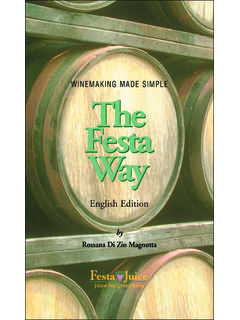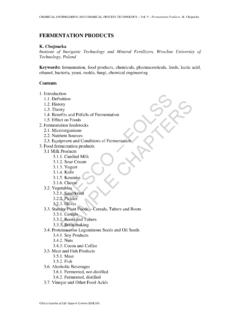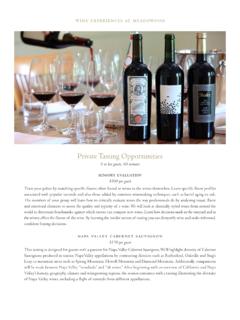Transcription of The Definitive Guide to Washing and Sanitizing Winemaking ...
1 The Definitive Guide to Washing and Sanitizing Winemaking Equipment Copyright Daniel Pambianchi 2012 Note: During the preparation of this article, it was learned that the BeterBottle division of High-Q, Inc. was conducting research into the use of enzyme detergents for Washing carboys. The advice and suggestions they provided are gratefully acknowledged. We can probably all agree that readying equipment for Winemaking is not exactly a carboy of fun; nevertheless, it is an absolutely crucial aspect of Winemaking . Reports of wine gone bad and, sadly, accidents resulting from improper Washing and Sanitizing of equipment and handling of chemicals are all too common pitted stainless steel, expensive oak barrels relegated to planter duty, shattered carboys, and trips to the hospital.
2 So, what is the difference between Washing and Sanitizing ? Which agents should be used to wash or sanitize a particular material? Does technique matter? How safe are these chemicals? Precise answers to these questions are complicated. Here, we provide basic information by reviewing the types of chemicals found in Washing and Sanitizing products, their effectiveness, resistance of equipment to these products, and suggestions for their safe and effective usage. UNDERSTANDING Washing AND Sanitizing Washing is the process of removing organic and inorganic contaminants to a level of insignificance.
3 Washing agents are designed to facilitate this process by breaking down, solubilizing, and dispersing contaminants into water, so the contaminants can be washed away. Latent microorganisms are capable of collecting nutrients and defending against attack by Sanitizing agents to go on and spoil wine in the making. For this reason, it is important that the Washing process be effective and adequately applied. Winemakers often use the terms sanitization and sterilization interchangeably; however, they are not equivalent.
4 Sterilization is the process of eradicating all living microorganisms by using specialized technology and methodologies, such as autoclaving. Autoclaving involves exposing items to high-pressure, saturated steam at 120 C (250 F) for 15 to 20 minutes certainly not a practical option for home Winemaking , and it is unnecessary. Pouring boiling water on, or into, equipment is not the same as autoclaving and doing so will not sterilize, it is unlikely to be as effective as using chemical Sanitizing agents, and can damage equipment.
5 Sanitization is a limited form of sterilization; it is the process of eradicating living microorganisms down to an acceptable level and which has no adverse effects on Winemaking . Bear in mind that a given Washing or Sanitizing agent may not be compatible with every type of material in Winemaking equipment. An agent that is suitable for use with stainless steel, for example, may severely damage glass, PET (polyethylene terephthalate), oak, food-grade plastics and rubbers, and other types of materials, or vice versa.
6 Washing and Sanitizing agents often do not come with sufficient and useful information to help us make informed decisions about which to use with what materials and under what conditions. The information on an agent's material safety data sheet (MSDS) is intended primarily as a warning regarding personal safety, not equipment safety, and is only required to list non-proprietary chemicals that are considered hazardous and that exceed 1% concentration. Let s look at the basics of Washing and Sanitizing , from pre-rinsing to the final rinse, and then review the types of agents and products available to accomplish these tasks.
7 PRE-RINSING As soon as you finish using a piece of equipment and while any organic material remains wet, rinse the equipment with a jet of cold tap water to dislodge the bulk of the material and finish with a jet of hot tap water. The hot water should not exceed 52 C (125 F). Water above this temperature is dangerously hot and is not necessary for effective pre-rinsing, and excessively hot water can damage many types of plastic equipment and is likely to cause soft (soda lime) glass carboys to expand unevenly and crack.
8 Keep rinsed equipment wet until you wash it and start Washing it promptly. PREPARING Washing / Sanitizing AGENTS Soaps are not up to the task of Washing equipment and very likely to leave residues (soap scum). Select Washing and Sanitizing agents that are compatible with your equipment (see compatibility table below) and follow these general rules: 1. Use hot water that is not more than 52 C (125 F). 2. Do not use higher concentrations than recommended by the manufacturers of the agents or your equipment. 3. Make up your working solutions of agents in a container that is made of a material known to be especially resistant to attack by the agents.
9 Always fill the container with water before adding the agent and when adding the concentrated agent, stir the water vigorously to ensure that the agent is quickly diluted and uniformly mixed. Adding a concentrated liquid or powdered agent to a container before adding water can damage the container. Washing How you wash will depend very much on what you are Washing ; however, certain generalizations can be made: 1. Don't soak your equipment for long periods in solutions of chemicals that are known to attack the materials from which the equipment is made.
10 Short exposure may be acceptable, even recommended, but avoid prolonged (overnight or longer) soaking. 2. Agitation and cautious rubbing will greatly facilitate the Washing process. However, whatever you use for rubbing should be sufficiently non-abrasive so that it will not scratch the surface of your equipment. Scratches will just make the equipment more difficult to wash the next time and can harbor microorganisms and other contaminations. 3. It is better to use your working solution of Washing agent in modest, repeated doses, rather than all in one shot.






